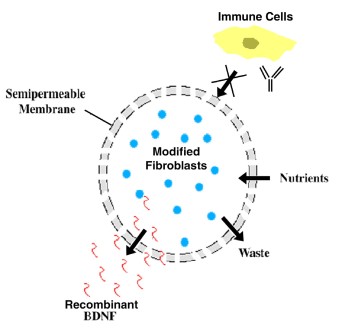Modified Fibroblasts Research
We use recombinant retrovirus vectors to genetically modify cells as a strategy of promoting survival of injured neurons and axon regeneration.
A retrovirus is a virus which has a genome consisting of two RNA molecules, which may or may not be identical to each other. It relies on the enzyme reverse transcriptase to perform reverse transcription of its genome from RNA to DNA, which can then be integrated into the host's genome with an integrase enzyme.
In our paradigm, we have used a retrovirus containing neurotrophic genes, either neurotrophin-3 (NT-3) or brain derived neurotrophic factor (BDNF) a marker gene, which allows us to track the genetically modified cells with various staining methods.
Genetic modification and grafting of fibroblasts into the injured spinal cord

Using these methods, the comlete rescue of injured neurons in Clarke's Nucleus by genetically modified cells that express NT-3 and the ability of cells that express BDNF to rescue injured neurons in the Red Nucleus (Himes et. al., 2001), induce regeneration of rubrospinal axons and promote significant functional recovery (Liu et. al., 1999; Liu et. al. 2002).

References
Transplants of cells genetically modified to express neurotrophin-3 rescue axotomized Clarke's nucleus neurons after spinal cord hemisection in adult rats (Abstract)
Himes BT1, Liu Y, Solowska JM, Snyder EY, Fischer I, Tessler A.
J Neurosci Res. 2001 Sep 15;65(6):549-64.
Transplants of cells genetically modified to express neurotrophin-3 rescue axotomized Clarke's nucleus neurons after spinal cord hemisection in adult rats (Full Report)
Himes BT, Liu Y, Snyder EY, Fischer I, Tessler A.
J. Neurosci. Res. 2001:65:549-564
Intraspinal delivery of neurotrophin-3 using neural stem cells genetically modified by recombinant retrovirus (Online Article)
Liu Y, Himes T, Solowska-Baird J, Moul J, Chow S, Tessler A, Snyder E, and Fischer I.
Experimental Neurology. 1999:158:9-26
Transplants of fibroblasts genetically modified to express BDNF promote regeneration of adult rat rubrospinal axons (Online Article)
Liu Y, Kim Y, Himes T, Chow S, Murray M, Tessler A, Fischer I.
J. Neuroscience. 1999:19:4370-4387
Intraspinal grafting of fibroblasts genetically modified by recombinant adenoviruses (Abstract)
Liu Y, Himes T, Moul J, Chow S, Jin H, Murray M, Tessler A, Fischer I.
NeuroReport. 1998:9:1075-1079
Encapsulation of genetically modified fibroblasts

We have shown that the immune response of the host can be circumvented by encapsulating our genetically modified fibroblasts inside a semi-permeable alginate capsule. Normally, the immune response is one of the most limiting factors in cellular transplant therapies. In this system, however, with immune cells prohibited from entering the membrane, the genetically modified fibroblasts are able to survive and produce BDNF without immune suppression.
Reference
Grafting of encapsulated BDNF-producing fibroblasts into inured spinal cord without immune suppression in adult rats (Abstract)
Tobias CA, Dhoot NO, Wheatley MA, Tessler A, Murray M, Fischer I.
J. Neurotrauma. 2001:18:287-301
Back to Top